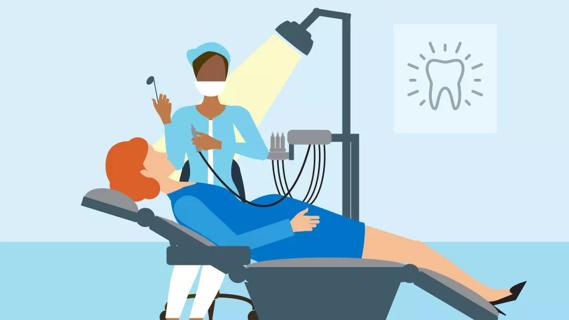Benefits typically include bi-annual screenings and lower payments on procedures like fillings and crowns

You’ve got a toothache, maybe even a cavity. And if you have dental insurance, it can help reduce the cost of treatment when you visit a dentist.
Advertisement
Cleveland Clinic is a non-profit academic medical center. Advertising on our site helps support our mission. We do not endorse non-Cleveland Clinic products or services. Policy
Similar to health insurance, dental insurance may be provided through your employer, but you can also get dental insurance from dental insurance companies.
So, how does dental insurance work? It lowers the out-of-pocket costs for services like crowns, fillings, root canals and dentures.
Sandra Goldbach, a patient financial counselor, explains how dental insurance works and the various types of dental insurance available.
Dental health insurance is a contract between you as a patient and the dental insurance plan you choose. Dental health benefit plans vary widely because each involves a negotiated contract between you or your employer, the dentist providing the care, a dental insurance carrier and sometimes an administrator responsible for processing and payment of claims. Your dentist as the provider has little impact on the assignment of benefits in your plan.
“Dental insurance is a valuable benefit to have. It allows for preventive care services on a regular basis to catch dental issues early when they are most treatable. Dental insurance also covers a portion of minor dental repairs like restorations,” explains Goldbach.
“Most plans will cover a percentage of major dental treatment, which tends to be the costliest and most extensive, but is so necessary in preserving the oral health of the patient. Oral health is paramount for the overall health of all people from nutritional needs to maintaining an infection-free mouth not allowing spread to other parts of the body.”
Advertisement
Dental insurance benefits are designed in several ways. You should know how your plan is designed, as this can significantly affect the plan’s coverage and your out-of-pocket expenses. Although the individual features of plans might differ somewhat, the most common designs can be grouped into the following categories:
This program reimburses you a pre-determined percentage of the total dollar amount spent on dental care, regardless of treatment category. This method typically doesn’t exclude coverage based on the type of treatment needed, allows you to go to the dentist of your choice and provides incentive for you to work with the dentist toward healthy and economically fair solutions.
These vary between contracted provider to contracted provider. Each dentist may have their own individual agreement with the insurance plan. A UCR usually allows you to go to the dentist of your choice. These plans pay a set percentage of the dentist’s fee or the plan administrator’s “reasonable” or “customary” fee limit, whichever is less. These limits might or might not accurately reflect the fees that area dentists charge. There are wide variations and lack of government regulation on how a plan determines the “customary” fee level.
This type of program determines a list of covered services with an assigned dollar amount. That dollar amount represents just how much the plan will pay for those services that are covered, regardless of the fee charged by the dentist. The difference between the allowed charge and the dentist’s fee is billed to the patient.
Capitation programs pay contracted dentists a fixed amount per enrolled family or patient. In return, the dentists agree to provide specific types of treatment to you at no charge. (For some treatments, there might be a co-payment.) The capitation premium that is paid might differ greatly from the amount the plan provides for your actual dental care.
Dental insurance typically covers the following categories:
“In most comprehensive dental insurance plans, preventive services are covered 100% with a frequency limit based on the number of times per year or within so many months per cycle,” says Goldbach. “This is dependent on benefit dollars available.”
Advertisement
Here’s a common scenario: You’ve used all of your benefit dollars for the calendar year. But you’ve only had one cleaning for the year, though you’re entitled to two cleanings. If you choose to have a second cleaning, you’ll be responsible for the fees.
“This is one of the most misunderstood aspects of coverage,” notes Goldbach.
Minor dental treatments like a restoration are often covered at 80%, leaving 20% co-insurance as patient liability. Major dental treatments are more often covered at 50% of the fee. For contracted insurance the percentage is related to the UCR contracted fee.
To control dental treatment costs, most plans limit the amount of care you can receive in a given year. This is done by placing a dollar cap — usually referred to as the “plan maximum benefit” — or limit on the amount of benefits you can receive, or by restricting the number or type of services that are covered. Some plans might totally exclude certain services or treatments to lower costs. And some plans have services only offered once in a lifetime. Find out specifically what services your plan covers and excludes.
There are, however, certain limitations and exclusions in most dental benefits plans that are designed to keep dentistry’s costs from going up without penalizing you. All plans exclude experimental procedures and services not performed by or under the supervision of a dentist, but there might be some less obvious exclusions.
Advertisement
An exclusion exemption may be an implant and the crown that follows. Some procedures like a crown may be limited to once every five to seven years.
“For these reasons, it’s always important for you to be aware of your policy benefits and limitations,” advises Goldbach.
Additionally, cosmetic procedures like veneers are typically excluded from insurance benefit coverage. If these are being done due to trauma or accident, they may be covered by your medical insurance.
Orthodontics is a specific category that may be covered depending on the policy. Some policies limit orthodontic treatment to 12 or 13 years of age. Other more comprehensive policies will allow for adult orthodontics.
“The most important thing to be aware of regarding orthodontic coverage is the total lifetime amount that the policy will pay out,” explains Goldbach. “The amount of benefit is significantly lower than what typical orthodontics cost, so the remainder of the costs will fall to patient liability.”
Sometimes, dental coverage and health insurance might overlap. Read and understand the conditions of your dental plan. Exclusions in your dental plan might be covered by your medical insurance.
Your dental insurance can be overwhelming and confusing.
Advertisement
Think about choosing a plan that imposes dollar or service limitations, rather than one that excludes categories of service. By doing so, you can receive the care that’s best for you and actively work with your dentist in the development of treatment plans that give the most and highest quality care.
To help you stretch each dental benefit dollar, most plans provide patients and purchasers with special administrative services. Find out if your plan provides the following mechanisms to help you budget, analyze and dispute, if necessary, the costs of your dental care:
A premium is the set amount that you pay a dental insurer for coverage. Most times, the amount will be deducted from your paycheck, but some policies may collect payment semiannually or annually.
Many employer-based dental insurance will offer a choice of coverage options. Each option will allow for more or less coverage depending on the premium paid. Coverage options include:
This is the amount you must pay for your dental expenses before your insurance will provide coverage. It’s common for your deductible to reset after 12 months.
“A deductible is a set amount (for example, $50 per year) and is assessed on the first procedure done within the benefit year,” explains Goldbach.
After you meet your deductible, co-insurance is the amount or percentage you’ll pay versus what your dental insurance plan will cover.
“For instance, a filling that costs $100 may be covered by insurance at 80% ($80) and this will leave a co-insurance amount of $20 (20%) for you to cover,” Goldbach illustrates. “Co-insurance helps to keep the policy premiums lower and helps to stretch out the yearly benefit dollars as well.”
This is a set amount of time before your dental insurance will provide full coverage on certain procedures. The amount of time can vary from plan to plan — anywhere from a few months to more than a year.
In many cases, your employer should offer dental insurance. And there are typically a few different options. If you haven’t signed up for dental insurance before, you may need to wait for the open enrollment period.
You want to ask yourself the following questions when determining what type of dental insurance is best for you:
“In choosing an insurance plan, whether through an employer or as an individual, it’s important to understand the policy in relation to your dental needs,” reiterates Goldbach. “I suggest obtaining a copy of the policy and read through its limitations, exclusions and particulars regarding waiting periods and benefit coverage. It’s helpful to know your needs or expected needs to compare the coverage.”
No dental insurance? If you don’t have dental insurance and need to receive treatment, there are options available:
It’s important to keep your teeth and gums healthy and stay on top of your oral hygiene — and dental insurance is a great option to help lower your out-of-pocket costs and it allows you to stay up-to-date on your preventive care.
“Your oral health is more important than you may realize,” says Goldbach. “Oral health is said to be a window into one’s overall health.”
Learn more about our editorial process.
Advertisement

Once you see that first tooth, it’s time to start brushing

Your teeth and gums have a huge role to play in other, more systemic health conditions

Oil pulling can help prevent plaque and preserve your gums, but it can’t cure ailments

Find out which viruses and bacteria can become someone else's problem

Help and encourage them to brush and floss regularly, limit sugary foods and get routine dental checkups

Estrogen and progesterone changes throughout the month — and throughout your life — can make you more prone to dental health concerns

Dental care is not only safe during pregnancy, but it’s also highly recommended

The numbness and tingling should wear off in about two hours

Type 2 diabetes isn’t inevitable with these dietary changes

Applying a hot or cold compress can help with pain